(Last updated: May 2021)
May can be spring, or May can be summer. Last year (2016) it was spring, with cloudy and showery weather, but this year so far it feels more like summer with dry breezes and lots of sun and not much May Gray yet — yet! The forecast is for it to turn back to spring for the upcoming second week of this month, with showers and cooler weather.
Cool weather is great planting weather. Take advantage, if you can.
Regardless, it’s already been plenty warm for subtropical plants to set fruit. Maybe your citrus and avocado trees are like mine: still blooming but also with pea-sized fruitlets. And maybe you planted some tomatoes in March that are already setting fruit. If May ends up being more warm like summer, we’ll even get to eat some by the end of the month.
But I chose the photo above to represent May because it’s the prettiest subtropical flower forming fruit this month in my yard. Passion fruit vines have everything beyond beauty going for them too: vibrant, evergreen foliage; vigorous growth to cover a fence or pergola; not messy when their fruit drops; tangy and tasty fruit; plus a fascinating etymology. Maybe you have a place to plant one — maybe next week?
Sometimes it feels like we live in paradise, friends. If you want to keep it going, here are some May opportunities in the yard:
Sow and plant
– Sow or plant these vegetables: tomatoes, peppers, beets, eggplant, beans, cucumber, corn, squash, melon, chard, basil
– Plant peppers and eggplant later in May if you want to be really smart about it; late May into early June is an ideal time to plant these heat lovers because if you plant earlier they’ll grow slowly and bugs can decimate them; however, if you plant later than mid-June you’re not going to get as much fruit as possible before it cools in the fall
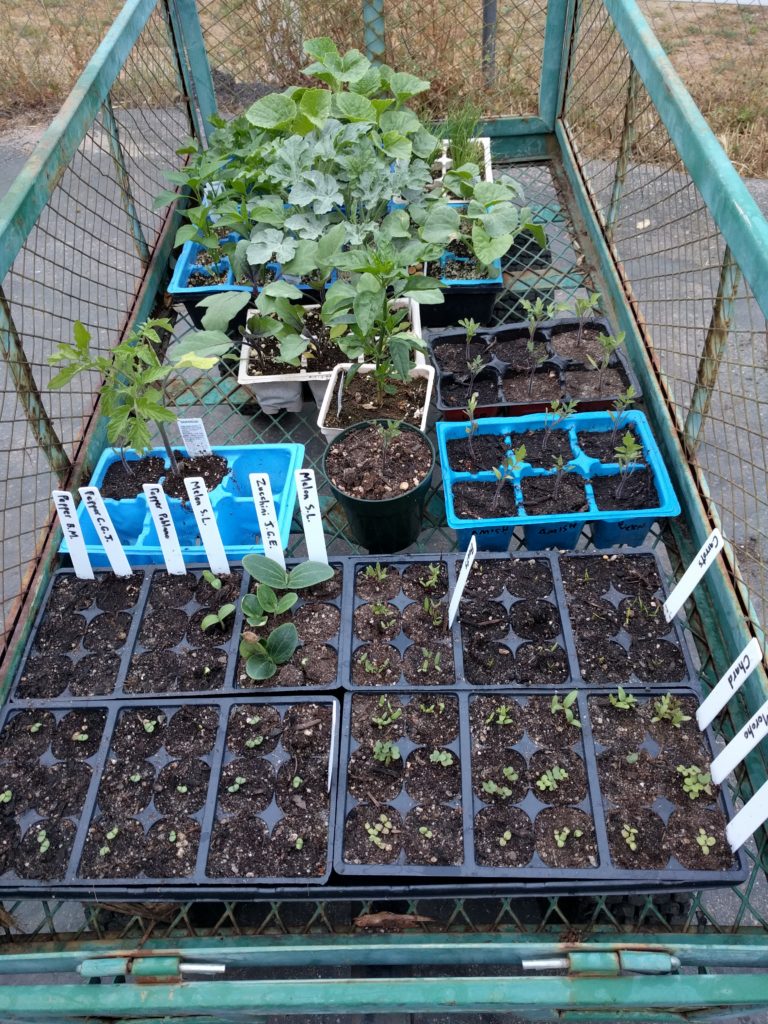
Harvest and eat
– Harvest wisely by doing it early in the morning for leaves of lettuce, chard, and kale; they are turgid at this hour — full of water and crunchy — and will taste best and keep fresh longest
– Stop watering onions and garlic that you planted last fall once their outer leaves start to yellow; they’ll continue to enlarge their bulbs on residual soil moisture; pick them to eat anytime, but wait until their tops are totally dead if you want to store them
– Eat these goodies (had you planted them): blueberries, strawberries, raspberries, blackberries, tomatoes (especially smaller-fruited types), potatoes, onion, garlic, broccoli (still a few final florets!), peas, lettuce, beets, carrots, peppers (if you overwintered a plant)
Miscellaneous
– Go hunting at night with a flashlight to see which bugs are eating your plants; in May, you might find earwigs on peppers, pill bugs on strawberries, june bugs on avocado leaves, slugs and snails on lettuce; pick them up and drown them in soapy water, collect them and feed them to chickens, throw them into your neighbor’s yard (unless you live next door to me), or squish them on sight
– Apple trees finally leaf out! (it’s scary how long they take to wake up in Southern California)
– Weed spotted spurge and purslane before they set seed; uproot and lay them on the ground upside down so they dessicate and decompose (but beware of purslane’s ability to root and regrow if it’s laid on moist soil)
– Note sun and shade patterns throughout the day; May through August patterns are about the same, in other words, you can grow a warm-season vegetable or a deciduous fruit tree in a spot that is sunny now but may be shady at other times of the year (north of a building, for example, like these pomegranates)
All of my Yard Posts are listed HERE

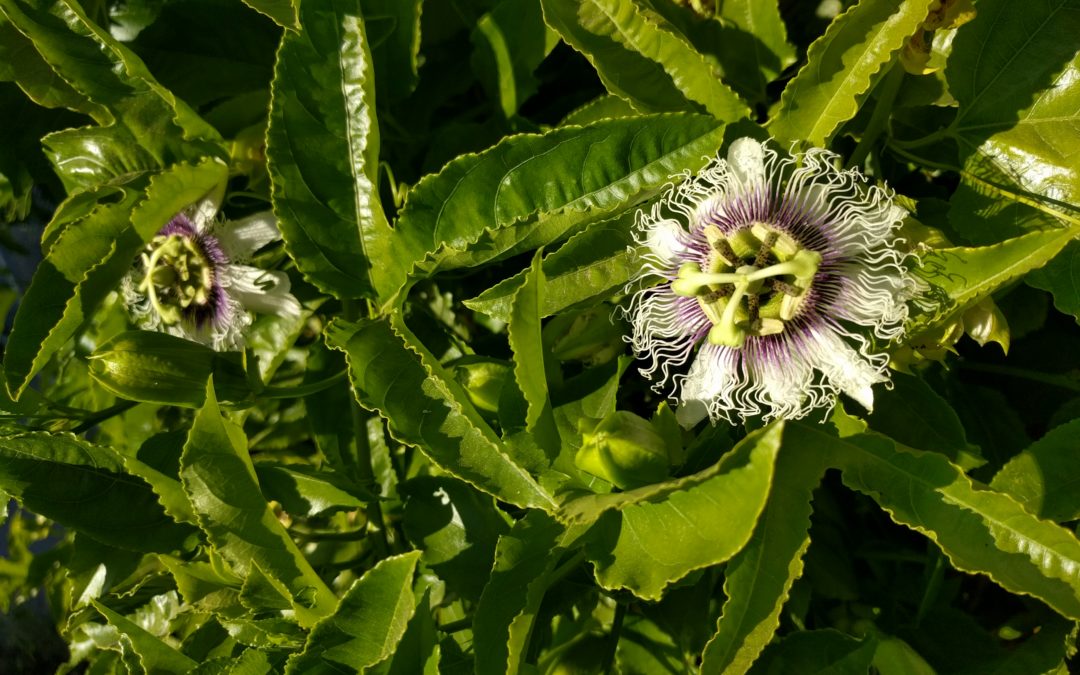
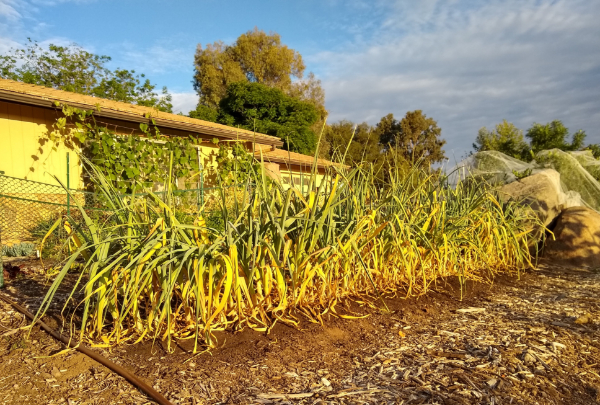
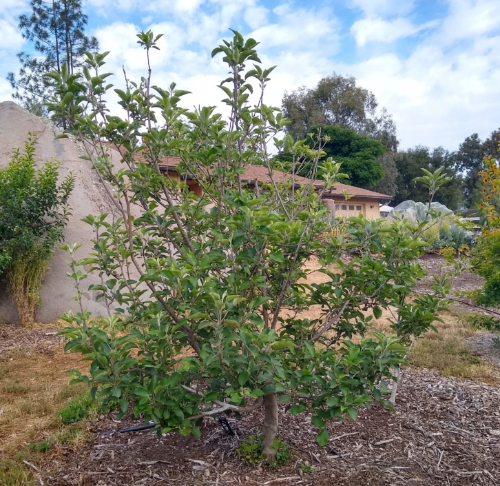
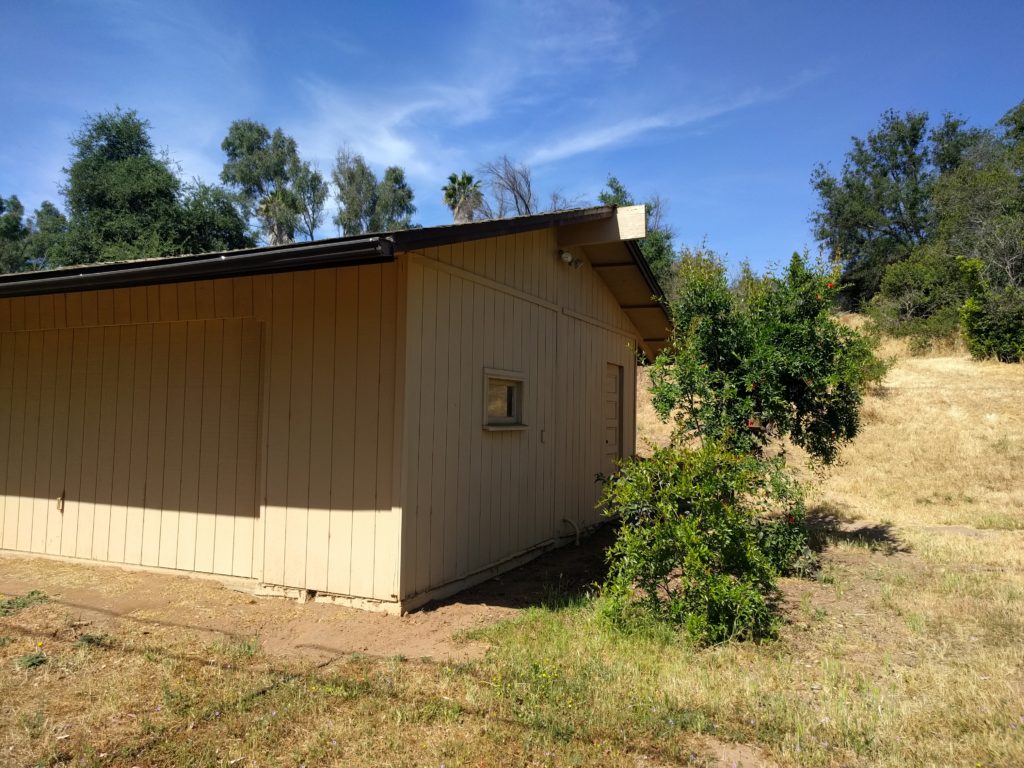


Great post as usual. Was about to plant peppers but will hold off until end of May. As an aside, avocado trees still mysterious. Two of my Fuertes must have 50-75 tiny fruits each. Third Fuerte mostly bare although bees assaulted this tree! Haas and 3 Sir Prize same as 3rd Fuerte. Most of the buds are gone so am I to assume no fruits?
Hi John,
What’s with that third Fuerte?! There are no more flowers emerging on the trees? If that’s the case here in May, then most likely no fruit this year.
This May (2020) and late April have been exceptionally warm. I’ve got the indicator weeds germinating in my yard (spotted spurge, purslane) that tell me that the soil is warm enough for peppers to be happy. Maybe that’s the case in yours too. I’d say you’re safe with a happy pepper planting at this point this year.
What variant is your passion vine? Mine is Tanaka and it is flourishing beyond all expectations.
Hi Robert,
I have had good results with Frederick, Possum Purple, and Nancy Garrison. I’ve never tried Tanaka. What’s the fruit like?
Sorry to be slow to reply. The vine is prolific and the fruit delicious. It is egg-sized, reddish-purple outside and yellow-orange inside – like most passion fruit I Imagine. I don’t pick them – I just wait for them to drop. I have photos but guess that I can’t post them here
Did I infer correctly that I can still plant beets? My first planting didn’t do much.
Hi Judy,
If you’re close to the beach, I’d say go ahead and continue planting beets. But if you’re more inland where the marine layer burns off early in the day and the soil has already warmed up a lot, you might not get great results from beets this late.
I’m harvesting a beet planting right now too, but I’m not sowing a new one, as I’m inland and beets do best for me outside of the heat of summer.
hi, i think i have lace bugs defoliating my 20 year old fuerte in vista ca. anyone have any suggestions for treatment? thank you!
Hi Rebecca,
I saw some trees that got hit particularly hard with lace bugs last summer in and near Fallbrook. Seems that lace bug populations exploded in that area last summer. Here is the best, up-to-date info on dealing with avocado lace bugs in Southern California: https://www2.ipm.ucanr.edu/agriculture/avocado/avocado-lace-bug/
Also, if you’re interested in learning about the latest research on avocado lace bugs for our area, you might join a webinar that Mark Hoddle is giving on July 7. Hoddle is an entomologist at UC Riverside, and he always gives excellent presentations. Here’s the link to more information on the webinar: https://ucanr.zoom.us/webinar/register/WN_cLBzzsbZS7GIgiDtSxqWBA
hello, thank you for the information! i will attend the webinar and read the information for sure. i also think my navel orange tree has asian psylid and think the county should come and look at it because it may need to be destroyed. the fruit is droppong while still mostly green with strange marks and shape and soft spots with no observable bug. do you know who i should report this to? thank you!
Hi Rebecca,
You’ll find a phone number to call on this page: https://californiacitrusthreat.org/protect-your-citrus/